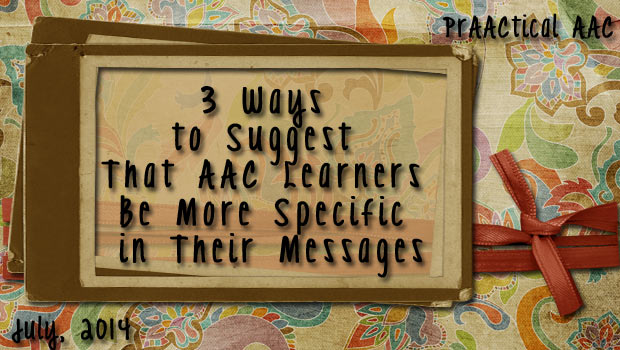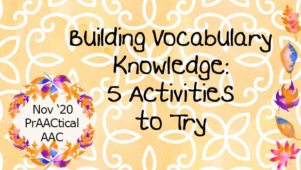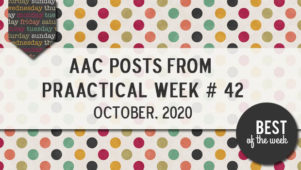3 Ways to Suggest That AAC Learners Be More Specific in Their Messages

Do you work with AAC learners who seem perfectly content saying things that are vague or non-specific, despite their ability to communicate more precisely? It puts a burden on the partner to use context to figure out the meaning, and sometimes this is efficient and quite necessary. Other times, however, it makes sense to seize the opportunity to teach them about saying things that are clear enough to be understood without relying on context or the partner’s knowledge of the AAC user.
Like you, we sometimes work with people who are learning to be more specific in the things that they say. For those learners, we try to balance enthusiasm and interest in the message with cues that direct them to add more information. We’ve noticed that some AAC practitioners are reluctant to press the learner to communicate in more specific terms, and we certainly agree that there are times when the focus is more on the content than on skill-building. But when language growth is the priority, we’re likely to say something that helps the learners understand the need to be clearer.
Here are some responses that can help AAC learners understand that more details are needed.
- “I’m not sure what you mean.”
- “So, I know that ___. But I’m not sure about ___. What am I missing?”
- “Here’s what I know so far…. Can you help me figure out the rest of it?”
Filed under: PrAACtical Thinking
Tagged With: clarity, language intervention, language therapy, specificity
This post was written by Carole Zangari





4 Comments
I think this is a great support idea. I have a student who relied on her partners for so long that when she got her eye gaze system, which is so much more efficient for her, she still would only put 1 context clue out there and then turn to the partner and wait for them to do the fill-in. It is that fine line of encouragement with increased demand. Thank you.
Susan, we’ve run across some very similar situations. It is difficult to break the habit of over-interpreting the message but, in many situations, that is the only way we’ve found to move the communicator toward independence. Like you said, there’s a fine line… Thanks for taking the time to share your thoughts on this.
Great advice. I love giving pointers to support staff in the classroom. My advice almost everyday is to allow plenty of time for processing and activating a message. Wait. Wait some more. And, you guessed it, wait some more. Bite your tongue. Try not to say, “C’mon.” “Push the button.” “Pick one.” “Make a choice.” Give one direction and wait awhile. If you still don’t get an answer, then give natural prompts like you suggested.
Love that advice, Ryan! Waiting quietly and expectantly is harder than it looks but so worth the it. Thanks for taking the time to stop by and comment.